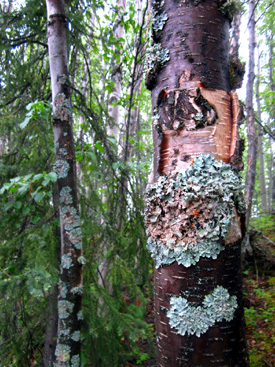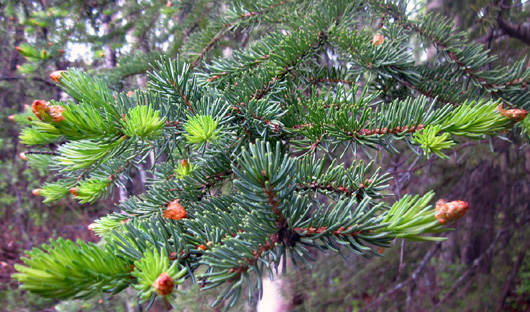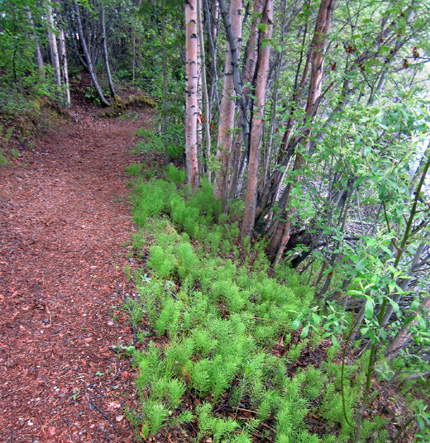One of the things that made our unexpected delay in the town of Watson
Lake more comfortable was nearby Wye Lake, which was developed into a
city park in 1989. It is easy to access and a wonderful resource for residents and
visitors.

I got into a habit of taking Cody for walks on the nice single track
dirt and boardwalk trail around the lake each morning. Some days we'd go
back again in the afternoon or evening. Out and back from our campsite
was about a three-mile roundtrip hike.
Cody enjoyed swimming in the
lake and sniffing all kinds of new scents:

I enjoyed the serenity; I usually saw only a handful of people
on the two-mile trail each time I was there. Nothing calms my mind and
body like a brisk hike in a scenic location.
This one offered a pretty
blue lake, interesting plants, and an abundance of wildlife:

One side of the lake is primarily wetlands and a large grassy
area with picnic tables and a gazebo.
The marsh is great habitat
for many species of birds and insects. One of the interpretive signs
says that 17 kinds of damselfly and dragonfly live at Wye Lake. It is
also the only place in the Yukon for the Wavy Waternymph, a delicacy for many ducks.
Wye Lake is on two of the major flyways for waterfowl
migrating between their summer nesting grounds in the north and
wintering grounds in the south:

Boreal habitats are critical for many species of birds. Open water helps
mark the route and provides food for their epic journey in both directions.
(Talk about ultra-distant athletes!)
Boardwalks and wooden bridges over wet areas on the loop trail at Wye
Lake help protect the
habitat and make walking around the lake more pleasant, especially after
all the rain this area has received in recent days:



Above and below: two views from one of the
observation decks in the marsh area

Three quarters of the loop trail
meanders through boreal forest, the term used to describe far northern
subarctic woods dominated by cone-bearing evergreens such as fir,
spruce, and pines, as well as deciduous aspen and birch trees.
Most of the boreal forests I've seen in northern New England and the
U.S. Rockies are also characterized by a lot of soft moss underfoot and
colorful lichens growing just about anywhere they want to grow:


My favorite part of the trail was through the aspens and
paper bark birch trees right at the edge of the lake:



Paper bark birch (L) and lichens
growing on aspen (R)

That part of the trail is where I also had some of the best views of the
water:

A solitary duck floats on the
lake.

Lily pads (foreground) and a colorful rental
facility in the park
Here are some more scenes from the forested part of the
trail:




The Wye Lake trail has a couple dozen interpretive signs describing
the flora and fauna found in this boreal habitat.
I'm familiar with most of the trees and flowers, such as birch, but
found the additional information about traditional uses by First
Nation** peoples to be interesting:

** First Nation is the designation for tribal people whose
ancestors lived in Canada before European explorers and settlers
arrived. According to this
website there are 14 First Nations in
the Territory, comprising about one quarter of Yukon's total population.
Some of the plants in the Yukon are new to me, like Crowberry:

Most berries this far north should be ready for bears, birds, and
humans to eat in July and August.
The soft, bright green plants in the picture below are
also new to me. They are very dense in some areas around the lake,
looking like a lush carpet under the trees:

As best as I can determine, that's
Common Horsetail, a member of the fern
family. If I'm wrong, please let me know what it is.
WHY WYE?
When I initially noted the First and Second Wye Lakes on the map of the town
of Watson Lake in Milepost I figured they were named after someone
named Wye.
Nope. One of the interpretive signs has the story:
The Alaska Hwy. was originally built near the airport, which is six
miles away from this town site of Watson Lake. The Y-shaped junction of
the access road was called the Watson Lake "Y" and this nearby lake
became known as Wye Lake.

Gazebo at Wye Lake Park
Ironically, the lake named Watson Lake is up near the airport.
If you're ever traveling through the Yukon on the Alaska Hwy. take
time to stop in the little town of Watson Lake long enough to enjoy this
city park containing the First Wye Lake.

It's a lovely place to have lunch and/or take a 45-minute stroll to
unwind before continuing north or south on your journey.
Next entry: continuing west and north on our
journey -- Watson Lake to Kluane Lake
Happy trails,
Sue
"Runtrails & Company" - Sue Norwood, Jim O'Neil,
and Cody the ultra Lab
Previous
Next
© 2012 Sue Norwood and Jim O'Neil

























